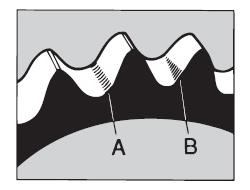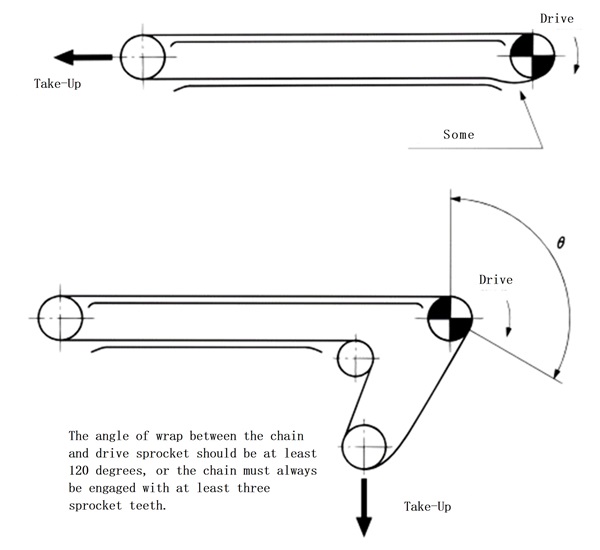Technical Data Small size conveyor chain Handling
Inspection
Frequently inspect the chain during the initial operating period in order to carry out necessary adjustment. Inspect the following items.
- (1)Unusual wear of chain.
- (2)Slack in chain.
- (3)Vibration and jerking of chain.
- (4)Unusual wear of sprocket, unusual contact of sprocket with other components due to eccentricity, debris accumulation in teeth valleys. When the sprocket properly engages with the chain, even contact is represented by the trace of contact shown as A in the illustration, while uneven trace of contact shown as B in the illustration represents improper installation of the sprocket or a twisted chain. Rechecking is needed. The normal point of impact is slightly up from the tooth root. However, when initial tension remains in the slacked side of the chain, the chain slightly contacts the valley. However, even in this case, strong contact should be traced around A. With idlers and tighteners, contact happens at the middle of the valley.

Fig. 28. Trace of Contact
- (5)Too much guide rail wear.
- (6)Any abnormality in the lubricating system.
・Causes of Vibration, Jerking, and Unusual Wear
- (1)Overload, glass fragments caught between components.
- (2)Warping of the chain on the return side.
- (3)Insufficient lubrication or no lubrication.
- (4)Wear of the sprocket.
- (5)Unusual wear or breakage of the chain.
Tension Adjustment
The correct amount of chain slack is essential for proper operation of the chain.
When the chain is too tight, working parts such as chain, sprocket wheel, shaft, bearings, etc., carry a much heavier load, accelerating chain wear. On the other hand, too much slack is also harmful and causes the chain to ride up on the sprocket teeth.
1. Frequency of Adjustment
The chain has a tendency to stretch a certain amount at the beginning of operation due to slight distortion of its components. After such initial elongation, the chain stretches slightly, but constantly, as a result of normal wear. To maintain proper chain tension, adjustments, if necessary, should be made at regular intervals.
Assuming eight hours of operation a day, the frequency schedule for inspection and adjustment is given in the table below. When working hours are increased, the frequency of adjustment should be increased accordingly. Neglecting careful inspection increases the chances of an accident.
| 1st week after start of operation | Once a day |
| 2nd to 4th week after start of operation | Twice a week |
| Thereafter | Twice a month |
2. Insufficient Take-Up Adjustment
If there is still excessive slack in the chain even after the take-up adjustment is fully tightened, shorten the chain by removing two links.
Refer to the procedure "How to Cut Chain" for the steps involved.

Fig. 27.Adjusting Chain Slack
3. Even Adjustment of Take-Up on Both Sides
Where two parallel chains are adjusted by two independently operated take-ups, care must be taken to ensure even stroke on both the left and right side (not needed when the take-ups are cooperating screw type or counterweight type).
An uneven adjustment will cause the link plate and the side of the sprocket teeth to interfere with each other and result in an overload condition. When the right and left sides are uneven, the two chains should be made even by replacing a portion of the right and left chains.

